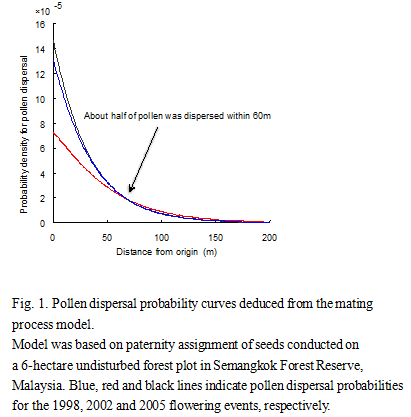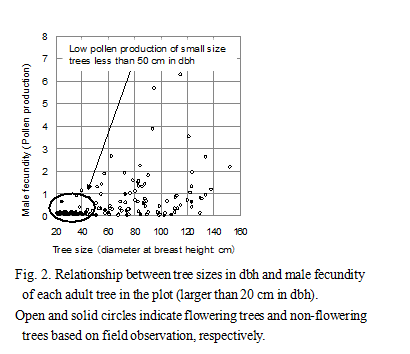Analyzing pollen dispersal of seraya (Shorea curtisii ) to promote healthy seed production to sustain forest regeneration
Description
Trees of timber species larger than 50 cm in trunk diameter at breast height (dbh) are being harvested in ongoing selective logging operations in Malaysia. This is a critical issue as these activities often result to a reduced number of healthy seedlings due to poor seed dispersal across logged-over areas and unsuccessful cross-mating among remaining adult trees.
This research addresses the problem by applying genetic paternity analysis of seeds to identify pollen dispersal patterns and by studying the relationship between tree size (dbh) and male fecundity (i.e. pollen production). It was done in order to come up with a proposal for forest management agencies in Malaysia to revise the selective logging criterion. The results of the study are expected to promote healthy seed production and consequently effect the development of a sustainable forest regeneration program.
Microsatellite genotypes were determined for all adult individuals in an undisturbed forest plot and seeds were collected in three synchronized flowering events for seraya (Shorea curtisii). Seraya is one of the major timber species in hill dipterocarp forests of Peninsular Malaysia where selective logging has been undertaken. Paternal donor of each seed was identified by comparing the genotypes of the seed, the mother tree and the paternal donor (paternity analysis). A model based on paternity analysis estimated pollen dispersal patterns.The average pollen dispersal distance was measured to be short at 60 m (Fig. 1).
The current harvesting criterion (dipterocarp trees larger than 50 cm dbh are felled) lowers the density and increases the distance between remaining adult trees, thereby decreasing the chances of pollen reaching other trees. Increasing remaining tree density helps promote cross-mating and improve the production of healthy seeds. Male fecundity of each adult tree estimated from the model based on paternity analysis showed that small-sized trees less than 50 cm in dbh left after selective logging seldom produced pollen (Fig. 2), resulting to fewer seeds produced from cross-mating. Selective logging simulation revealed that conserving the middle-sized trees(70-90cm dbh) ensured about 50% of outcrossing pollen produced to be retained, which was higher than the current logging protocol (5-15%, logging larger than 50 cm trees). This research established pollen dispersal patterns and studied the relationship between tree size (in dbh) and pollen production. The results will be compiled in support of the proposal to the Selangor Forest Department for a revised selective logging criterion to rejuvenate healthy cross-mating of seraya and consequently, sustain forest regeneration.
Figure, table
- Affiliation
-
Japan International Research Center for Agricultural Sciences Forestry Division
- Classification
-
Research
- Research project
- Program name
- Term of research
-
FY 2011 (FY 2005-FY 2015)
- Responsible researcher
-
Tani Naoki ( Forestry Division )
KAKEN Researcher No.: 90343798Tsumura Yoshihiko ( Forestry and Forest Products Research Institute )
KAKEN Researcher No.: 20353774Taguchi Yuriko ( Forestry and Forest Products Research Institute )
Niiyama Kaoru ( Forestry and Forest Products Research Institute )
KAKEN Researcher No.: 70353795Otani Tatsuya ( Forestry and Forest Products Research Institute )
KAKEN Researcher No.: 80353613Yagihashi Tsutomu ( Forestry and Forest Products Research Institute )
Fukazawa Keita ( National Institute for Environmental Studies )
Kado Tomoyuki ( Graduate University for Advanced Studies )
Lee Soon Leong ( Forest Research Institute Malaysia )
Lee Chai Ting ( Forest Research Institute Malaysia )
Muhammad Norwati ( Forest Research Institute Malaysia )
Kassim Abdul Rahman ( Forest Research Institute Malaysia )
Ripin Azizi ( Green Forest Resources )
- ほか
- Publication, etc.
-
Tani et al.(2012) Journal of Ecology 100(2):405-415
- Japanese PDF
-
2011_15_A4_ja.pdf163.72 KB
- English PDF
-
2011_15_A4_en.pdf56.75 KB


